Tyrant flycatcher
| Tyrant flycatchers | |
|---|---|
| Scissor-tailed Flycatcher Tyrannus forficatus |
|
| Scientific classification | |
| Kingdom: | Animalia |
| Phylum: | Chordata |
| Class: | Aves |
| Order: | Passeriformes |
| Suborder: | Tyranni |
| Family: | Tyrannidae Vigors, 1825 |
| Genera | |
|
Some 100, see text |
|
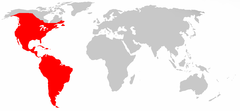 |
|
| Distribution of tyrant flycatchers | |
The tyrant flycatchers (Tyrannidae) are a family of passerine birds which occur throughout North and South America, but are mainly Neotropical in distribution. They are now considered the largest family of birds on Earth, with around 400 species. In every country in the Americas, except for the United States and Canada, they are the most diverse avian family. As could be expected from a family this large, the members vary greatly both in shape, patterns and colours. Some Tyrant flycatchers superficially resemble the Old World flycatchers. They are members of suborder Tyranni (suboscines) that do not have the sophisticated vocal capabilities of the songbirds.
Most, but not all, are rather plain, and many have erectile crests. As the name implies, most are insectivorous, but some will eat fruit or small vertebrates (e.g. small frogs). The smallest family members are the closely related Short-tailed Pygmy Tyrant and Black-capped Pygmy Tyrant. With a total length of a mere 6.5-6.8 cm (2.5-2.7 in) and a weight of 4-5 grams, they are the smallest passerines on earth. The largest tyrant flycatcher is the Great Shrike-Tyrant at 29 cm (11.5 in) and 88 grams (3.1 oz). A few species such as the Streamer-tailed Tyrant, Scissor-tailed Flycatcher and Fork-tailed Flycatcher have a larger total length, but this is mainly due to their very long tails.
A number of species previously included in this family are now placed in the family Tityridae (see Systematics).
Contents |
Habitat and distribution
Species richness of Tyrannidae, when compared to habitat, is highly variable. The habitats of tropical lowland evergreen forest and montane evergreen forest have the highest single site species diversity while many habitats including rivers, palm forest, white sand forest, tropical deciduous forest edge, southern temperate forest, southern temperate forest edge, semi-humid/humid montane scrub, and northern temperate grassland have the lowest single species diversity. The variation between the highest and the lowest is extreme; ninety species can be found in the tropical lowland evergreen forests while the number of species that can be found in the habitats listed above typically are in the single digits. This may be due in part to the fewer niches found in certain areas and therefore fewer places for the species to occupy.
Tyrannidae specialization among habitat is very strong in tropical lowland evergreen forests and montane evergreen forests. These habitat types therefore display the greatest specialization. The counts differ by three species (tropical lowland evergreen forests have 49 endemic species and montane evergreen forests have 46 endemic species). It can be assumed that they both have similar levels of specialization.
Regionally, the Atlantic Forest has the highest species richness with the Chocó following closely behind.
Protected status
The Northern Beardless Tyrannulet (Camptostoma imberbe) and the Rose-throated Becard (Pachyramphus aglaiae) are protected under the Migratory Bird Treaty Act of 1918.[1]. Both these species are common south of the US border. The situation for a number of other species from South and Central America is far more problematic. In 2007, BirdLife International (and consequently IUCN) considered two species, the Minas Gerais Tyrannulet and Kaempfer's Tody-Tyrant critically endangered. Both are endemic to Brazil. Additional, 7 species were considered endangered and 18 species vulnerable.[1]
Systematics
There are about 400 species in 97 genera. A full list, sortable by common and binomial names is at list of tyrant flycatchers. Species in the genera Tityra, Pachyramphus, Laniocera and Xenopsaris have been placed in this family, but evidence strongly suggest they belong in Tityridae[2], where now placed by SACC.
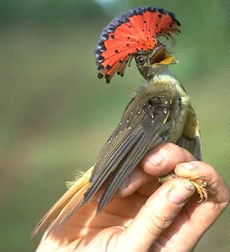


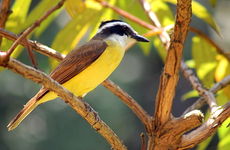
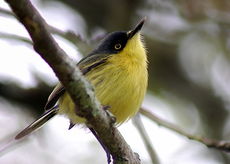
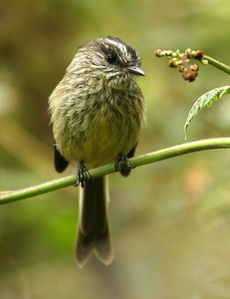
- Genus Ornithion (3 species)
- Genus Camptostoma (2 species)
- Genus Phaeomyias - Mouse-colored Tyrannulet
- Genus Nesotriccus - Cocos Island Flycatcher
- Genus Capsiempis - Yellow Tyrannulet
- Genus Tyrannulus - Yellow-crowned Tyrannulet
- Genus Myiopagis (7 species)
- Genus Pseudelaenia - Gray-and-white Tyrannulet
- Genus Elaenia (18 species)
- Genus Serpophaga (5 species)
- Genus Mionectes (5 species)
- Genus Leptopogon (4 species)
- Genus Pseudotriccus (3 species)
- Genus Phylloscartes (23 species)
- Genus Phyllomyias (14 species)
- Genus Zimmerius (10 species)
- Genus Sublegatus (3 species)
- Genus Suiriri (2 species)
- Genus Mecocerculus (6 species)
- Genus Inezia (4 species)
- Genus Stigmatura (2 species)
- Genus Anairetes - tit-tyrants (8 species)
- Genus Tachuris - Many-colored Rush-tyrant
- Genus Culicivora - Sharp-tailed Grass-Tyrant
- Genus Polystictus (2 species)
- Genus Pseudocolopteryx (4 species)
- Genus Euscarthmus (2 species)
- Genus Myiornis (4 species)
- Genus Lophotriccus (5 species)
- Genus Oncostoma (2 species)
- Genus Poecilotriccus (12 species)
- Genus Taeniotriccus - Black-chested Tyrant
- Genus Hemitriccus - typical tody-tyrants (20 species)
- Genus Todirostrum - typical tody-flycatchers (7 species, others now in Poecilotriccus)
- Genus Corythopis - antpipits (2 species)
- Genus Cnipodectes (2 species)
- Genus Ramphotrigon (3 species)
- Genus Rhynchocyclus (4 species)
- Genus Tolmomyias (5 species)
- Genus Platyrinchus - spadebills (7 species)
- Genus Onychorhynchus - Royal Flycatchers (1-4 species, depending on taxonomy)
- Genus Myiotriccus - Ornate Flycatcher
- Genus Myiophobus (9 species)
- Genus Terenotriccus - Ruddy-tailed Flycatcher
- Genus Myiobius (5 species)
- Genus Neopipo - Cinnamon Tyrant
- Genus Pyrrhomyias - Cinnamon Flycatcher
- Genus Hirundinea - Cliff Flycatcher and Swallow Flycatcher
- Genus Cnemotriccus - Fuscous Flycatcher
- Genus Lathrotriccus (2 species)
- Genus Aphanotriccus (2 species)
- Genus Xenotriccus (2 species)
- Genus Mitrephanes (2 species)
- Genus Contopus - pewees (14 species)
- Genus Empidonax (15 species)
- Genus Sayornis - phoebes (3 species)
- Genus Pyrocephalus - Vermilion Flycatcher
- Genus Ochthoeca (9 species)
- Genus Tumbezia - Tumbes Tyrant
- Genus Colorhamphus - Patagonian Tyrant
- Genus Ochthornis - Drab Water-tyrant
- Genus Cnemarchus - Red-rumped Bush-tyrant
- Genus Myiotheretes (4 species)
- Genus Xolmis (8 species, including Heteroxolmis)
- Genus Neoxolmis - Chocolate-vented Tyrant
- Genus Agriornis - shrike-tyrants (5 species)
- Genus Polioxolmis - Rufous-webbed Tyrant
- Genus Muscisaxicola - ground-tyrants (13 species)
- Genus Muscigralla - Short-tailed Field-tyrant
- Genus Lessonia (2 species)
- Genus Knipolegus - black-tyrants (11 species)
- Genus Hymenops - Spectacled Tyrant
- Genus Fluvicola - typical water-tyrants (3 species)
- Genus Arundinicola - White-headed Marsh-tyrant
- Genus Alectrurus (2 species)
- Genus Gubernetes - Streamer-tailed Tyrant
- Genus Satrapa - Yellow-browed Tyrant
- Genus Colonia - Long-tailed Tyrant
- Genus Machetornis - Cattle Tyrant
- Genus Muscipipra - Shear-tailed Gray Tyrant
- Genus Attila - attilas (7-8 species)
- Genus Casiornis (2 species)
- Genus Sirystes - Sirystes
- Genus Rhytipterna (3 species)
- Genus Myiarchus (22 species)
- Genus Deltarhynchus - Flammulated Flycatcher
- Genus Pitangus - kiskadees (2 species, includes Philohydor)
- Genus Megarynchus - Boat-billed Flycatcher
- Genus Myiozetetes (4-5 species)
- Genus Conopias (4 species)
- Genus Myiodynastes (5 species)
- Genus Legatus - Piratic Flycatcher
- Genus Phelpsia - White-bearded Flycatcher
- Genus Empidonomus - Variegated Flycatcher
- Genus Griseotyrannus - Crowned Slaty Flycatcher (formerly in Empidonomus)
- Genus Tyrannopsis - Sulphury Flycatcher
- Genus Tyrannus - kingbirds (13 species)
References
- ↑ BirdLife International (2007). Species factsheets. Accessed 12 December 2007 available online
- ↑ Adopt the Family Tityridae - South American Classification Committee (2007)
External links
- Tyrant Flycatcher videos on the Internet Bird Collection